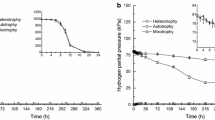Summary
Carbon distribution from substrates to products in Clostridium acetobutylicum ATCC 824 was investigated by adding 14C-labeled substrates as tracers. Comparison of carbon conversion between chloramphenicol (CAP)-treated and untreated cultures was also studied. The percentage of 14C recovery in butanol, acetone and ethanol from uniformly labeled [14C]glucose was increased by 17, 25 and 30%, respectively, after CAP addition. The incorporation of 14C in solvents from 14C-labeled acetate and butyrate was also increased by the antibiotic treatment. A total 14C recovery of 12% in all the products from added [14C]Na2CO3 indicates significant heterotrophic CO2 fixation in this microorganism. The ratio of carbon in butanol derived from glucose, acetate and butyrate was about 71:6:18, and this ratio was unchanged by CAP treatment.
Similar content being viewed by others
References
Bahl H, Andersch W, Braun K, Gottschalk G (1982a) Effect of pH and butyrate concentration on the production of acetone and butanol by Clostridium acetobutylicum grown in continuous culture. Eur J Appl Microbiol Biotechnol 14:17–20
Bahl H, Andersch W, Gottschalk G (1982b) Continuous production of acetone and butanol by Clostridium acetobutylicum in a two-stage phosphate limited chemostat. Eur J Appl Microbiol Biotechnol 15:201–205
Byrne GA (1965) The separation of 2,4-dinitriphenylhydrazones by thin layer chromatography. J Chromatogr 20:528–540
Cooper TG (1977) The tools of biochemistry. Wiley, New York, pp 65–135
Davies R (1942) Studies on the acetone-butyl alcohol fermentation. 2. Intermediates in the fermentation of glucose by C. acetobutylicum. 3. Potassium as an essential factor in the fermentation of maize meal by C. acetobutylicum. Biochem J 36:582–599
Fond O, Matta-Ammouri G, Petitdemange H, Engasser JM (1985) The role of acids on the production of acetone and butanol by Clostridium acetobutylicum. Appl Microbiol Biotechnol 22:195–200
Haggstrom L, Forberg C (1986) Significance of an extracellular polymer for the energy metabolism in Clostridium acetobutylicum: a hypothesis. Appl Microbiol Biotechnol 23:234–239
Jones DT, Woods DR (1986) Acetone-butanol fermentation revisited. Microbiol Rev 50:484–524
Lentz K, Wood HG (1955) Synthesis of acetate from formate and carbon dioxide by Clostridium acetobutylicum. J Biol Chem 215:645–654
Manganelli RM, Brofazi FR (1957) Quantitative determination of volatile acids by paper chromatography for application to sewage sludge digestion. Anal Chem 29:1441–1443
Martin JR, Petitdemange H, Gay R (1983) Effects of acetic and butyric acids on solvents production by Clostridium acetobutylicum. Biotechnol Lett 5:89–94
Petrowitz HJ (1969) Synthetic organic products. In: Stahl E (ed) Thin layer chromatography, 2nd edn. Springer Berlin Heidelberg New York, pp 660–662
Shriner RL, Fuson RC, Curtin DY (1956) The systematic identification of organic compounds, 4th edn. Wiley, New York, p 219
Thauer RK (1973) CO2 reduction to formate in Clostridium acidiurici. J Bacteriol 114:443–444
Wiegel J, Braun M, Gottschalk G (1981) Clostridium thermoautotrophicum species novum, a thermophile producing acetate from molecular hydrogen and carbon dioxide. Curr Microbiol 5:255–260
Wood HG, Brown RW, Werkman CH (1945) Mechanism of the butyl alcohol fermentation with heavy carbon acetic and butyric acids and acetone. Arch Biochem 6:243–261
Yerushalmi L, Volesky B, Leung WK, Neufeld RJ (1983) Variations of solvent yield in acetone-butanol fermentation. Eur J Appl Microbiol Biotechnol 18:279–286
Zhou X, Traxler RW (1992) Enhanced butanol production and reduced autolysin activity after chloramphenicol treatment of Clostridium acetobutylicum ATCC 824. Appl Microbiol Biotechnol 37:293–297
Author information
Authors and Affiliations
Additional information
This paper represents contribution No. 2685 of the Rhode Island Agricultural Experimental Station
Correspondence to: R. W. Traxler
Rights and permissions
About this article
Cite this article
Zhou, X., Traxler, R.W. Comparison of carbon metabolism between chloramphenicol-treated and untreated cultures of Clostridium acetobutylicum . Appl Microbiol Biotechnol 38, 254–258 (1992). https://doi.org/10.1007/BF00174478
Received:
Accepted:
Issue Date:
DOI: https://doi.org/10.1007/BF00174478




